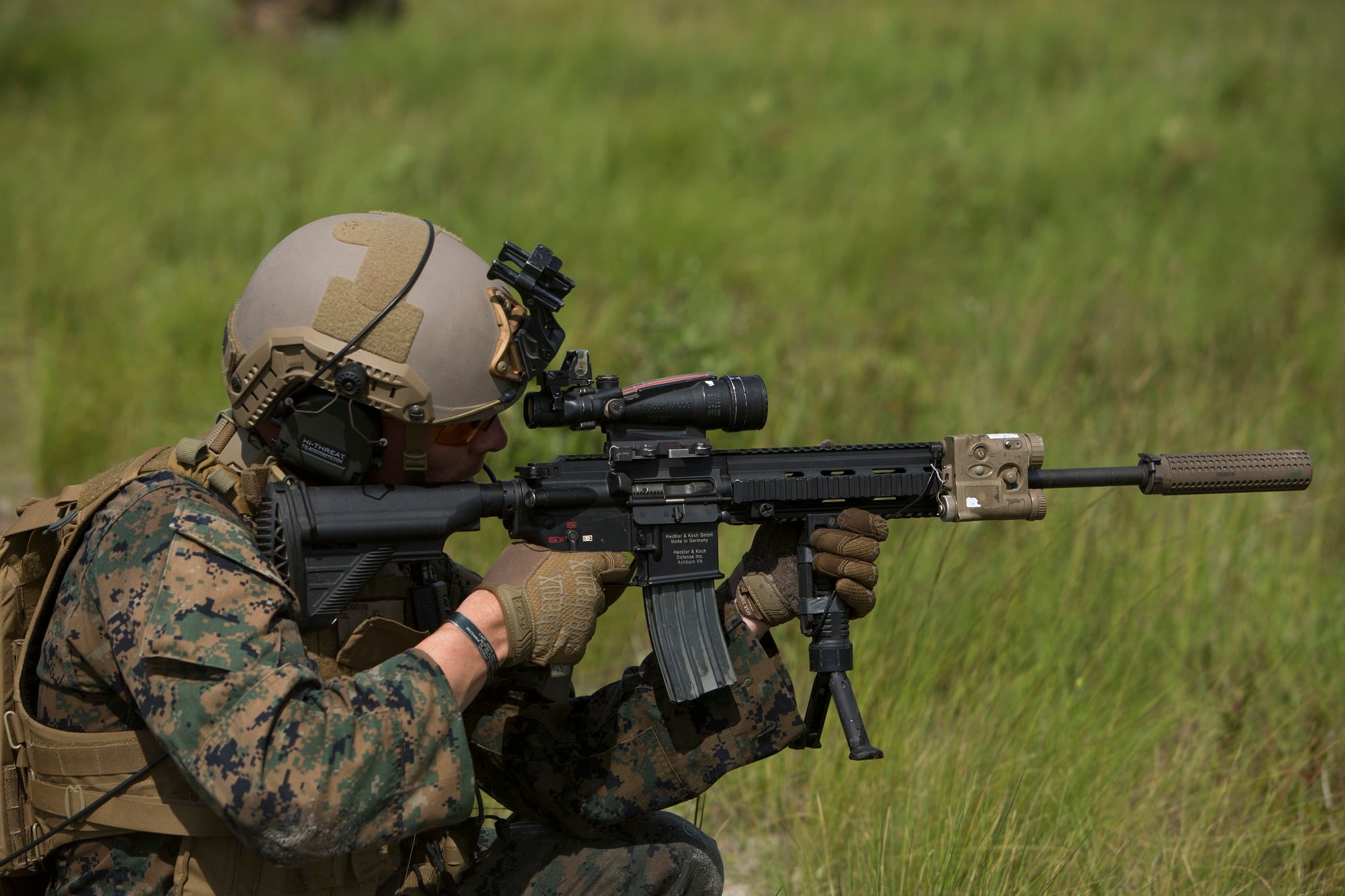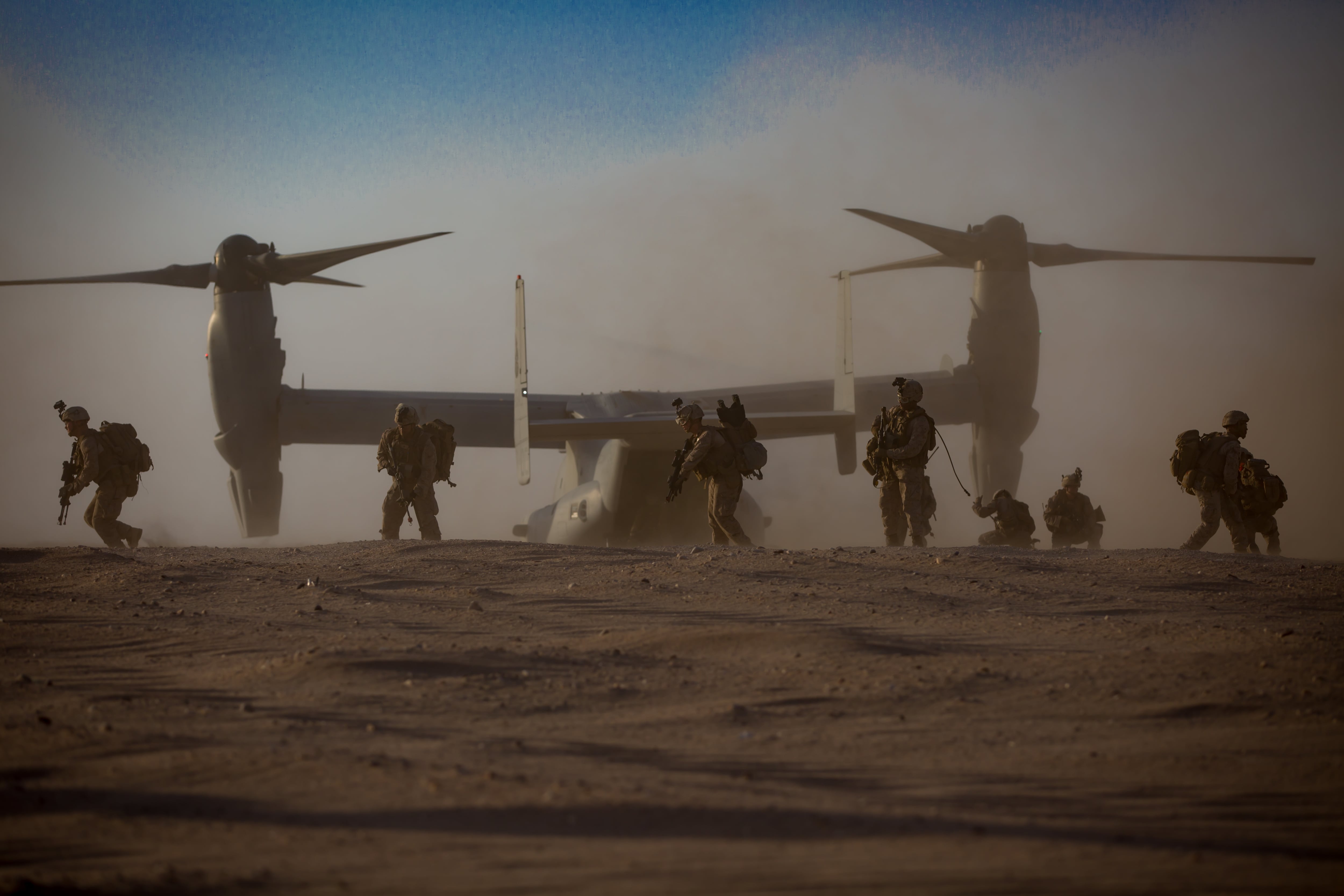The Marine Corps is on track to fulfill many of the promises it has made to overhaul grunts and prepare the force for a more sophisticated modern battlefield.
The plan calls for new tech, gear, training and various structural changes to hone massive combat power within the rifle squad.
But the rapid pace of the Corps’ modernization efforts invites a host of manpower challenges, especially as the Corps expects tepid growth over the coming year.
And the Corps is facing down serious questions as to whether it can tackle America’s ever-expanding irregular warfare in the developing world while also modernizing a force for a bout with near-peer threats.
RELATED

Some changes already have taken place.
So far this year, the Corps has completed fielding all 32 infantry battalions with small quadcopter drones as part of the top Marine’s “Quads for Squads” initiative.” It has qualified nearly 1,000 Marines since 2016 to help rain down precision air and naval gun fire as part of an effort to increase lethality of the Corps’ rifle squads.
And to date, the Corps has fielded 5,636 brand new M27 Infantry Automatic Rifles and has completed its issuing of the marksmen version of the IAR, known as the M38, to all the three Marine Expeditionary Forces, according to Barbara Hamby, a spokeswoman for Marine Corps Systems Command.
The Marines just received the first of one of the most powerful heavy lift helicopters in the U.S. arsenal: the CH-53K. It plans to take delivery of the first new amphibious combat vehicle by spring of 2019. The force is still amid plans to overhaul the MV-22 into a refueling gunship. And the Corps has embarked on a bold plan to procure its first group five futuristic sea drone, dubbed the MUX.
The Corps contends its new expensive toys are needed for the Marines to survive as a distributed force across the vastness of the Pacific Ocean in the face of rising ballistic missile threats from peer competitors like China.
The Marines are boosting firepower with a new suite of weapons and skills within one of its most building blocks of combat power, the rifle squad, and beefing up air capabilities to help the force move massive quantities of supplies and troops.
The changes will afford the Corps to operate with independence and as small decentralized fighting units across the Pacific.
However, these programmatic changes in tech and gear and structural changes may leave the Corps with serious manpower shortages or too few systems to adequately handle future threats as the Corps tackles more problems than it can realistically handle.
STAFFING REALITY
While these programs are moving at near light speed, there appears to be a real disconnect between the Corps’ intellectual notions to modernize and the reality of staffing the Corps to manage these changes.
“The Marine Corps wants all the new stuff like cyber, wants to sustain contributions to special operations command, wants to beef up higher headquarters like the MEF information group, or intel and comms,” Dakota Wood, a senior fellow for the Heritage Foundation and former retired Marine officer, told Marine Corps Times.
“And since they are not growing the size of the force appreciably they have to find that manpower from other places.”
The rifle squads appear to be the first victim in the Corps’ sprint to modernize.
The decision by Gen. Robert B. Neller, the commandant of the Marine Corps, to cut a Marine from the rifle squad frees up Marines to be staffed elsewhere across the Corps in areas like cyber and intel.
But it enacts a high price on the rifle squad at a time when operational reports and evaluations suggest “more people are needed, not fewer,” Wood argues.
The new 12-man rifle squad model “doesn’t allow for fire teams to stand watches in pairs or to be able to sustain operations in the face of attrition,” Wood said.
The Corps has routinely argued new night vision, automatic weapons, anti-tank rockets like the 84 mm Carl Gustaf recoilless rifle, drones and tablets will continue to boost lethality of infantry units despite the loss of a Marine from the squad.
The Marines are also heavily leaning on the retention of top tier talent within the infantry, like squad leaders and Marines trained at the Corps’ Infantry Small Unit Leaders Course. And the Corps is targeting massive bonuses to influence decisions by these Marines to stay in the service.
But the Corps is already facing a shortage of squad leaders, and new tech and gear may not necessarily plug the gap in manpower.
“New things are additions not replacements,” Wood said.
There is a real cost that is enacted with these developments being pushed by the Corps.
“I think where they [Marine Corps] are at intellectually is good,” Wood added. “But we are seeing a big gap between the intellectual development of these concepts, the likely programmatic changes and what they are buying and how they are organizationally structured.”
Right now the Corps is “unwilling to make hard calls about what it won’t do,” Wood argues.
Take for example the Corps’ push to rapidly modernize its aviation.
The Corps is procuring new CH-53K heavy lift helicopters and expects to turn its Ospreys into an air refueling gunship.
The new V-22 Aerial Refueling System for the Osprey is currently in the development phase. Testing will kick off in fiscal year 2019 and the system is expected to be in use in the fleet by FY 2021, according to Sarah Tate, a spokeswoman with Naval Air Systems Command. The Osprey as a refueler will boost the range of fighter aircraft like the F-35B, which will help in the expanse of the Pacific theater.
And the Corps wants to upgrade the MV-22’s underbelly Gatling gun, known as the Defensive Weapon System, so it can fly escort missions.
The Corps is also pushing for its first group five drone, known as the MUX, that it wants with all the bells and whistles to include airborne early warning, kinetic and electronic attack, and communications relay.
But the Corps lacks institutional knowledge in staffing and operating large group five drones and has been piggybacking off the Air Force to learn on the job.
All these developments are aimed at the near-peer battle and the Corps’ notions of distributed operations in the Pacific.
And while the Corps does all of this, it is still working with the Air Force to potentially procure an old school turboprop plane like Textron Aviation’s AT-6 Wolverine or the A-29 Super Tucano to fight in more permissive counterinsurgency type battlefields.

Any decision to field a new aircraft for America’s irregular warfare battlefields will come structural adjustments to the force that could impact everything from needing more maintainers to pilots, manpower the Corps has little slack to maneuver in.
“The Marine Corps continues to monitor the Air Force-led Light Attack Experiment to procure a cost-effective, observation and attack (OA-X) air platform for employment in permissive environments,” Capt. Christopher Harrison, a Marine spokesman, told Marine Corps Times in an emailed statement.
“Currently, the Marine Corps is examining potential force structure options for the platform while the Air Force assesses the viability of the two nondevelopmental, light-attack aerial platforms in the experiment.”
The value added by any new light attack will greatly depend on the “time and attention,” the Corps invests into the new aircraft and a decision by the Corps on “where it wants to focus,” Wood explained.
The Corps has a great history of being innovative on the battlefield, Wood added. The Corps introduced helicopters to the fight, tilt rotor aircraft, and has solved complicated tactical issues with opposed amphibious landings.
But the Corps “needs to start learning how to say no,” Wood said.
To work out some of these issues, the Corps needs more “robust experimentation,” according to Wood.
The Corps has carried out various experimentation exercises like Sea Dragon, which has helped the Corps to lock down on future gear and tech.
But the Corps appears to be overextending itself as it attempts to juggle all of America’s national security concerns.
The Marines want to staff its new information groups with intel professionals while building a cyber force and staffing more than 3,000 special operators at the Raider battalions and building an elite infantry force. It’s taking on a host of challenges without a real focus on what its primary mission should be.
The Corps’ mantra is to be most ready when the nation is least ready, but with budgetary constraints, expensive new toys and small growth the Marines Corps could find itself in a readiness crisis.
More robust experimentation could help the Corps iron out some of the wrinkles by bringing to light where shortages exist and how the Corps can best employ the tech and manpower it has for the fighting concepts it has recently developed, or it will highlight for the Corps what is realistically feasible.
Shawn Snow is the senior reporter for Marine Corps Times and a Marine Corps veteran.




